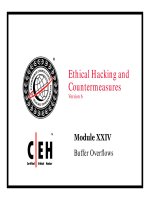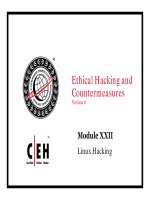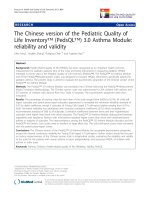Module 24 Buffer Overflows potx
Bạn đang xem bản rút gọn của tài liệu. Xem và tải ngay bản đầy đủ của tài liệu tại đây (1.41 MB, 47 trang )
Ethical Hacking and
Countermeasures
Countermeasures
Version 6
Module XXIV
Module XXIV
Buffer Overflows
News
EC-Council
Copyright © by EC-Council
All Rights Reserved. Reproduction is Strictly Prohibited
Source: />Scenario
It was a job that Tim wanted right from the start of his
career. Being a Project Manager at a well-known software
firm was definitely a sign of prestige. But now, his
credibility was at stake.
The last project that Tim handled failed to deliver because
the application crashed. The customer of Tim's company
suffered a hu
g
e financial loss.
g
At the back of his mind, something was nagging Tim
Had he asked his Test Engineers to do a thorough testing of
hdl d k h ld h h d
t
h
e
d
e
l
ivere
d
pac
k
age, t
h
is wou
ld
not
h
ave
h
appene
d
.
EC-Council
Copyright © by EC-Council
All Rights Reserved. Reproduction is Strictly Prohibited
Module Objective
• Buffer Overflows
R f b ff fl tt k
This module will familiarize you with :
•
R
easons
f
or
b
u
ff
er
over
fl
ow
a
tt
ac
k
s
• Understanding Stacks and Heaps
• Types of buffer overflow
• Detectin
g
buffer overflows in a
p
ro
g
ram
gpg
• Attacking a real program
• Defense Against Buffer Overflows
• Buffer overflow detection tools
•
Libsafe
•
Libsafe
• Simple buffer overflow in C
EC-Council
Copyright © by EC-Council
All Rights Reserved. Reproduction is Strictly Prohibited
Module Flow
Buffer Overflows Attacking a real program
Reasons for
Buffer Overflow Attacks
Defense Against
Buffer Overflows
Understandin
g
Buffer Overflow Attacks
Buffer overflow
Buffer Overflows
g
Stacks and Heaps
Libsafe
detection tools
Si l b ff fl i C
Detecting buffer
Libsafe
Types of buffer overflow
EC-Council
Copyright © by EC-Council
All Rights Reserved. Reproduction is Strictly Prohibited
Si
mp
l
e
b
u
ff
er
over
fl
ow
i
n
C
Detecting buffer
overflows in a program
Real World Scenario
Source: />EC-Council
Copyright © by EC-Council
All Rights Reserved. Reproduction is Strictly Prohibited
Why are Programs/Applications
Vulnerable
Vulnerable
Boundary checks are not done fully or in most cases they are skipped entirely
Boundary checks are not done fully or
,
in most cases
,
they are skipped entirely
Programming languages such as C have errors in it
Programming languages
,
such as C
,
have errors in it
The strcat(), strcpy(), sprintf(), vsprintf(), bcopy(), gets(), and scanf() calls in C
language can be exploited because these functions do not check to see if the
language can be exploited because these functions do not check to see if the
buffer, allocated on the stack, is large enough for the data copied into the buffer
P / li ti t dh d t d i ti
P
rograms
/
app
li
ca
ti
ons
are
no
t
a
dh
ere
d t
o
goo
d
programm
i
ng
prac
ti
ces
EC-Council
Copyright © by EC-Council
All Rights Reserved. Reproduction is Strictly Prohibited
Buffer Overflows
A generic buffer overflow occurs when a buffer that has been allocated a
ifi h d i d i h i h dl
spec
ifi
c
storage
space,
h
as
more
d
ata
cop
i
e
d
to
i
t
t
h
an
i
t
can
h
an
dl
e
Consider the following source code. When the source is compiled and turned
into a program and the program is run it will assign a block of memory 32
into a program and the program is run
,
it will assign a block of memory 32
bytes long to hold the name string
#include<stdio.h>
int main ( int argc char
**
argv)
int
main
(
int
argc
,
char
argv)
{
char target[5]=”TTTT”;
char attacker[11]=”AAAAAAAAAA”;
strcpy( attacker,” DDDDDDDDDDDDDD”);
printf(“%
\
n
”,target);
return 0;
}
EC-Council
Copyright © by EC-Council
All Rights Reserved. Reproduction is Strictly Prohibited
This type of vulnerability is prevalent in UNI
X
- and NT-based systems
Reasons for Buffer Overflow
Attacks
Attacks
Buffer overflow attacks depend on two things:
• The lack of boundary testing
• A machine that can execute a code that resides in the data/stack segment
The lack of boundary is common and, usually, the program ends with the
segmentation fault or bus error
In order to exploit buffer overflow to gain access to or escalate privileges the
In order to exploit buffer overflow to gain access to or escalate privileges
,
the
offender must create the data to be fed to the application
Random data will
g
enerate a se
g
mentation fault or bus error
,
never a remote
gg ,
shell or the execution of a command
EC-Council
Copyright © by EC-Council
All Rights Reserved. Reproduction is Strictly Prohibited
Knowledge Required to Program
Buffer Overflow Exploits
Buffer Overflow Exploits
C f ti d th t k
C f
unc
ti
ons
an
d th
e
s
t
ac
k
A littl k l d f bl / hi l
A littl
e
k
now
l
e
d
ge
o
f
assem
bl
y
/
mac
hi
ne
l
anguage
Ho s stem calls a e made (at the machine code le el)
Ho
w
s
y
stem calls a
r
e made (at the machine code le
v
el)
e ec( ) s stem calls
e
x
ec( ) s
y
stem calls
Ho to guess some ke parameters
EC-Council
Copyright © by EC-Council
All Rights Reserved. Reproduction is Strictly Prohibited
Ho
w
to guess some ke
y
parameters
Understanding Stacks
The stack is a (LIFO) mechanism
that computers use to pass
arguments to functions as well as to
refer to the local variables
SP
refer to the local variables
It acts like a buffer, holding all of the
BP
anywhere
within the
SP
points
here
It acts like a buffer, holding all of the
information that the function needs
within
the
stack
frame
The stack is created at the beginning
of a function and released at the end
of it
Stack
growth
direction
EC-Council
Copyright © by EC-Council
All Rights Reserved. Reproduction is Strictly Prohibited
direction
Understanding Heaps
The heap is an area of memory utilized by an application and
is allocated dynamically at the runtime
is allocated dynamically at the runtime
Static variables are stored on the stack along with
the data allocated using the malloc interface
the data allocated using the malloc interface
EC-Council
Copyright © by EC-Council
All Rights Reserved. Reproduction is Strictly Prohibited
Simple Heap Contents
Types of Buffer Overflows: Stack-
Based Buffer Overflow
Based Buffer Overflow
A stack overflow occurs when a buffer has been overrun in the stack space
Malicious code can be pushed on the stack
The overflow can overwrite the return pointer so that the flow of control switches to the
malicious code
C language and its derivatives offer many ways to put more data than anticipated into a
buffer
Consider an example program given on the next slide for simple uncontrolled overflow
•The
p
ro
g
ram calls the bof() function
EC-Council
Copyright © by EC-Council
All Rights Reserved. Reproduction is Strictly Prohibited
pg
• Once in the bof() function, a string of 20 As is copied into a buffer that holds 8 bytes, resulting in a
buffer overflow
A Simple Uncontrolled Overflow of
the Stack
the Stack
/* This is a program to show a simple uncontrolled overflow of the stack. It will
overflow EIP with 0x41414141, which is AAAA in ASCII. */
#include <stdlib.h>
#include <stdio.h>
#include <string.h>
int bof()
{
char buffer[8]; /* an 8 byte character buffer */
strcpy(buffer,"AAAAAAAAAAAAAAAAAAAA"); /*copy 20 bytes of A into the buffer*/
return 1; /*return this will cause an access violation due to stack corruption */
return
1;
/*return
,
this
will
cause
an
access
violation
due
to
stack
corruption
.
*/
}
int main(int argc, char **argv)
{
bof(); /*call our function*/
/*print a short message, execution will never reach this point because of the
overflow*/
printf(“Lets Go\n");
EC-Council
Copyright © by EC-Council
All Rights Reserved. Reproduction is Strictly Prohibited
return 1; /*leaves the main function*/
}
Stack Based Buffer Overflows
Bottom of Stack
Data on Stack
S
Bottom of Stack
Data on Stack
S
Bottom of Stack
Data on Stack
S
Some data
may be
S
e
g
ment
SP
S
e
g
ment
Return Address
4 Bytes
S
e
g
ment
New Return Address
may be
overwritten
4 Bytes
More Data on
Stack Segment
n Bytes
Overwritten Data
on Stack Segment
Machine Code. Ex.
Execve(/bin/sh)
n Bytes +
new data
End of Stack
kh k ll
SP SP
khf i
EC-Council
Copyright © by EC-Council
All Rights Reserved. Reproduction is Strictly Prohibited
A Normal Stack
Stac
k
, w
h
en Attac
k
er ca
ll
s
a function
Stac
k
, w
h
en
f
unct
i
on
smashes a stack
Types of Buffer Overflows: Heap-
Based Buffer Overflow
Based Buffer Overflow
Variables that are dynamically allocated with functions such as
Variables that are dynamically allocated with functions
,
such as
malloc(), are created on the heap
In a heap-based buffer overflow attack, an attacker overflows a buffer
that is placed on the lower part of heap, overwriting other dynamic
variables, which can have unexpected and unwanted effects
If an application copies data without first checking whether it fits into
the target destination, the attacker could supply the application with a
piece of data that is large, overwriting heap management information
In most environments, this may allow the attacker to control over the
program
’
s execution
EC-Council
Copyright © by EC-Council
All Rights Reserved. Reproduction is Strictly Prohibited
program s execution
Heap Memory Buffer Overflow Bug
/*heap1.c – the simplest of heap overflows*/
#include <stdio.h>
#i l d dlib h
#i
nc
l
u
d
e <st
dlib
.
h
>
int main(int argc, char *argv[])
{
{
char *input = malloc (20);
char *output = malloc (20);
strcpy (output, "normal output");
strcpy (input, argv[1]);
printf ("input at %p: %s\n", input, input);
printf ("output at %p: %s\n", output, output);
printf(
"
\
n
\
n%s
\
n
"
, output);
EC-Council
Copyright © by EC-Council
All Rights Reserved. Reproduction is Strictly Prohibited
printf(
\
n
\
n%s
\
n,
output);
}
Heap-Based Buffer Overflow
input=malloc(20);
output
=
malloc(20);
“
normal output
\
0
”
XXXXXXXXXXXXXXXXXXXX
output malloc(20);
normal output
\
0
XXXXXXXXXXXXXXXXXXXX
Heap: Before Overflow
input=malloc(20);
output=malloc(20);
rdfnordfnord\0fnordfnordfnordfnordfnord fn0
EC-Council
Copyright © by EC-Council
All Rights Reserved. Reproduction is Strictly Prohibited
Heap: After Overflow
Understanding Assembly Language
The two most important operations in a stack:
The two most important operations in a stack:
• 1. Push – put one item on the top of the stack
• 2. Pop – "remove" one item from the top of the stack
Till h i d b i d h
T
yp
i
ca
ll
y,
returns
t
h
e
contents
po
i
nte
d
to
b
y
a
po
i
nter
an
d
c
h
anges
the pointer (not the memory contents)
EC-Council
Copyright © by EC-Council
All Rights Reserved. Reproduction is Strictly Prohibited
Shellcode
Shellcode is a method to exploit stack
-
based overflows
Shellcode is a method to exploit stack
based overflows
Shellcodes ex
p
loit com
p
uter bu
g
s in how the stack is handled
ppg
Buffers are soft targets for attackers as they overflow easily if the
conditions match
"\x2d\x0b\xd8\x9a\xac\x15\xa1\x6e\x2f\x0b\xdc\xda\x90\x0b\x80\x0e"
conditions match
"\x92\x03\xa0\x08\x94
\
x
1a
\
x
80
\
x
0a
\
x
9c
\
x
03
\
x
a0
\
x
10
\
xec\x3b
\
x
bf
\
x
f0"
"\xdc\x23\xbf\xf8\xc0\x23\xbf\xfc\x82\x10\x20\x3b\xaa\x10\x3f\xff"
"\x91\xd5\x60\x01\x90\x1b\xc0\x0f\x82\x10\x20\x01\x91\xd5\x60\x01"
EC-Council
Copyright © by EC-Council
All Rights Reserved. Reproduction is Strictly Prohibited
How to Detect Buffer Overflows
in a Program
in a Program
There are two ways to detect buffer overflows:
There are two ways to detect buffer overflows:
One way is to look at the source code
• In this case, the hacker can look for strings declared as local variables in
functions or methods and verify the presence of boundary checks
• It is also necessary to check for improper use of standard functions,
especially those related to strings and input/output
Another way is to feed the application with huge amounts of data
and check for the abnormal behavior
EC-Council
Copyright © by EC-Council
All Rights Reserved. Reproduction is Strictly Prohibited
Attacking a Real Program
A
ssumin
g
that a strin
g
function is bein
g
ex
p
loited
,
the attacker can
gg gp,
send a long string as the input
This string overflows the buffer and causes a segmentation error
This string overflows the buffer and causes a segmentation error
The return
po
inter
o
f the functi
o
n is
o
verwritten
,
an
d
the attacker
po o o o , d
succeeds in altering the flow of execution
If th h t i t hi d i th i t h / h h t
If th
e
user
h
as
t
o
i
nser
t hi
s
co
d
e
i
n
th
e
i
npu
t
,
h
e
/
s
h
e
h
as
t
o:
• Know the exact address on the stack
• Know the size of the stack
EC-Council
Copyright © by EC-Council
All Rights Reserved. Reproduction is Strictly Prohibited
• Make the return pointer point to his code for execution
NOPS
Most CPUs have a No Operation (NOP) instruction – it does nothing but advance the
instruction pointer
instruction pointer
Usually, you can put some of these ahead of your program (in the string)
As long as the new return address points to a NOP, it is OK
Attacker pads the beginning of the intended buffer overflow with a long run of NOP
instructions (a NOP slide or sled) so the CPU will do nothing until it gets to the 'main
event' (which preceded the 'return pointer')
Most intrusion detection systems (IDSs) look for signatures of NOP sleds
ADMutate
(by K2) accepts a buffer overflow exploit as input and randomly creates a
EC-Council
Copyright © by EC-Council
All Rights Reserved. Reproduction is Strictly Prohibited
ADMutate
(by K2) accepts a buffer overflow exploit as input and randomly creates a
functionally equivalent version (polymorphism)
How to Mutate a Buffer Overflow
Exploit
Exploit
For the NOP portion
• Randomly replace the NOPs with functionally equivalent segments
of code (e.g.: x++; x-; ? NOP NOP)
For the NOP portion
A l XOR t bi d ith d k i t lli ibl t
For the "main event"
•
A
pp
l
y
XOR t
o
com
bi
ne
co
d
e
w
ith
a
ran
d
om
k
ey
un
i
n
t
e
lli
g
ibl
e
t
o
IDS. The CPU code must also decode the gibberish in time in order
to run the decoder. By itself, the decoder is polymorphic and,
therefore, hard to spot
R d l t k LSB f it t l d i th NOP
For the "return pointer"
EC-Council
Copyright © by EC-Council
All Rights Reserved. Reproduction is Strictly Prohibited
•
R
an
d
om
l
y
t
wea
k LSB
o
f
po
i
n
t
er
t
o
l
an
d i
n
th
e
NOP
-zone
Once the Stack is Smashed
Once the vulnerable
p
rocess is commandeered
,
the attacker has
p,
the same privileges as the process and can gain normal access.
He/she can then exploit a local buffer overflow vulnerability to
gain super-user access
Create a backdoor
• Using (UNIX-specific) inetd
• Using Trivial FTP (TFTP) included with Windows 2000 and some
UNIX flavors
• Shoot back an Xterminal connection
Use Netcat to make raw and interactive connections
EC-Council
Copyright © by EC-Council
All Rights Reserved. Reproduction is Strictly Prohibited
• UNIX-specific GUI









